Dark Cave
One knows how to combine constructional elements to achieve wanted effects - however what-why-how-is-working mostly remains hidden. One knows well terms like ´mass, inertia, weight, attraction or repulsion etc.´ by common handling of parts and particles - however the real cause of these appearances was not detected up to now. Like Platon did show with his famous ´cave-parable´ long times ago, we obviously see and know respective handle only ´shadow-figures´ - and only occasionally we get an idea what´s going on outside the ´dark cave´. We try hard to learn the real background of appearances and events. We possibly could have better success by changing the point of view: at the foreground must exist a real basis resulting seemingly phenomena.
Dark Matter
Commonly is assumed, an atom exists by ´nothing´ for the most part. Only the elementary particles (electrons, protons, neutrons or their sub-elementary-particles) are assumed to exist really. So as a whole these ´known masses´ would represent an even smaller part of the universe. Based on common understanding, nothing can be build of nothing. Total emptiness in general can not exist, no matter that ´vacuum´ is empty or only somehow empty. Otherwise all material particles would disperse into ambient space of ´no-thing´ immediately. As a substitute, additional fictive prerequisites must be assumed, e.g. like weak and strong atomic forces. These are considered ´naturally really existing´, however only because necessary for common atom-models. Realiter one was never able to explain, why and how the atoms should keep together, how that wanted function could be achieved - a typical case of previous ´cave-parable´.
Free and Bound Aether
Only one sort of aether is necessary to allow all physical appearances. For example, the atoms differ to previous Free Aether only by their internal movement-structures. Such local units build a stabile compound of individual motion-pattern and thus here in general are called ´Bound Aether´. Like mentioned upside, only maximum five percent of all volume of the universe is in shape of Bound Aether (GA, red) and - beside others - ´manifests the material particles´. The remaining major volumes (outside at space and naturally also between atoms) is Free Aether (FA, light-grey).
Radiation and chaotic Motion
Radiation demands no medium, by common understanding, because it´s running also through vacuum. Radiation is assumed to be any kind of motion, however a ´moving nothing´ can not exist. Finally if one assumes whole space is filled up by the aether, logical results each radiation is a certain motion of the aether.
All radiations can mutually overlay. At each spot outside there within Free Aether, thus swinging movements of all kind are overlaying. The aether is pulled to-and-fro continuously into all three directions of space. This ´jumbled mixture´ results just chaotic seeming knots of motions, where every ´aetherpoint´ is moving at only short sections of track, swirling around as a cluster of motions within relative narrow space. Nevertheless it´s possible to filter a certain frequency out of that chaotic mash, by relative simple devices - e.g. by the ´mysterious´ function of a radio-receivers.
Speed, Density, Energy-Constant
The sound is a motion-pattern within the air. In principle the pressure-front is a compression, followed by immediate decompression. Only that motion-structure is moving forward within space, each air-particle is only swinging some forward and back again, in principle however keeping its location.
The sound-movement is forwarded from particle to particle, with different speeds depending on the density of the medium. In addition, at each ´elastic push´ between particles, a part of the kinetic energy is lost (finally into the ´nothing´ of common understanding). The sound spreads aside and becomes weaker and weaker - because the transport is bound to material particles.
As now the photon-movement is forwarded through the aether by unchanged speed for years, the medium must show corresponding higher density. If the light merely looses intensity at that long way, it can not be transported via elastic push from one aether-particle to the next. Analogue to previous sound, the kinetic energy finally would get lost into that ´nothing´ (the gaps between particles of the medium). So it´s stringent logic conclusion: the aether can not be build by separated particles, but must be a gapless whole.
At first sight this might seem impossible. As the aether is the unique real existing substance, it well can show that ´unusual´ materia-property. The aether as basis of all physical appearances compelling must be that continuum, because only within that medium kinetic energy never can get lost. The energy-constant is superior nature-law, otherwise the universe would have died the cold-death since long. All motions of particles inevitably result friction- respective heat-losses. Thus the real background of all appearances can only be a part-less medium.
Impossible
Tesla´s idea of a "waver-thin basic substance which swirls around by immense speed at never ending vortices" is much more plausible. Strange enough only Einstein explicit stated in later years, the "inevitable existing aether can not again be build by ponderable particles". However he was not able to draw the consequences of that gapless ´aether-plasma´ (and up to now the RT-protagonists refuse to take notice of these later statements of mature Einstein).
At the second row are marked some red points, which are moving towards left. Such linear motions are not possible, because left side of the aetherpoint no empty space is available. All aetherpoints left side should have to move further left, through whole universe. Also all aetherpoints of right side should have to follow, because within that aether no gaps can come up. At third row some points are moving towards right. This is also not admitted, in general no parts can shift relative to each other within that coherent medium.
Upside was mentioned the Free Aether is steady ´trembling´. At B a track of straight motions is sketched - however the aether can never move like this. The ´aether-mass´ is inert and because each movement of an aether-points involves all neighbours, such abrupt decelerations and accelerations into other directions can not exist (and also the interia of all ´material masses´ is based on this background).
Likely impossible are rotating movements (e.g. like a mechanic wheel is turning around its axis). At C a red point is moving at circled track and outside of some blue points are stationary. Within the aether by itself, never can come up such ´scissors-motions´ and never some parts or areas can scrape alongside each other.
Swinging in many Variations
An important limitation is sketched at E. There are drawn six red, narrow neighbouring points. Simplistic the tracks are assumed to be circles. All neighbouring points within gapless aether in principle must keep constant distances all times. If one point is moving at circle track, all neighbours must behave synchronous, thus must swing at corresponding circle tracks.
Cone, Crank, Double-Crank
This enlargement of swinging-radius is an essential characteristic of aether-movements. Also the Free Aether is moving at many circled tracks, however only at short round sections. Starting from that ´trembling´ a radius of a circle-track can become longer (while the radius of other part-circles may become shorter), so the motion-pattern of these cones can come up.
If all aether would be completely resting, that mass would show infinite high inertia. However all aether is anywhere swinging, also the Free Aether. Its motion is a combination of many round track-sections, which finally are closed within each other. These motion-pattern are not completely rigid, but the axis of track-section may tilt and the radius may vary. The kinetic energy of Free Aether keeps constant as a whole, e.g. even when the tracks are stretched in shape of previous cone.
The track most wide finally must be reduced again to the narrow swinging of Free Aether. This cone at A thus must be complemented by a mirrored cone. This shape is called ´double-cone´ or is also called a ´crank´ (e.g. because the crank-shaft of one-cylinder-motor is an ´edged´ variation of). At this picture upside right at B such a crank is sketched with a round connecting line. This line starts left from ´resting´ Free Aether (blue point) and is ending right side again with a ´stationary´ blue point. The neighbouring aetherpoints of the connecting-line are moving at enlarged radius, where the red point at the middle shows the swinging at most wide range (see arrow).
A spiral connecting line is drawn between the Free Aether, represented by both blue points left and right. The line shows the mantle of two ´spindles´ (marked light red) during its swinging motion. The red aetherpoint left side did swing up, while same time the red aetherpoint right side momentary is positioned most down. So at the moment, upside-left exists ´too much´ aether, upside-right however ´too less´ volume exists. So the aether should ´slosh´ from left to right side, like marked by dotted arrow. Below the situation is opposite and ´some aether´ should swing from right to left side.
When the turning of the double-crank goes on, the balancing movements must work contrary. Finally results the motion pattern of a double-crank also at the vertical direction. This arrangement is a very important motion-pattern, because it allows compensation within a local area. For example this is the motion principle within an electron and a hydrogen-atom, thus the most appearances within universe (see next chapter).
Balancing-Areas, Aether-Pressure
All local motion-units thus all times are embedded within a ´balancing-area´, where movements of ambient aether are transformed into swinging-pattern of the inner space. At picture 09.02.04 below left at D that principle is drawn schematic. The Free Aether (light grey) can be called relative ´resting or stationary´ (here represented by light-blue). The border-section with the transition of movement-pattern is marked light-red. From this balancing-area further inward comes up the ordered swinging at increasing longer radius (marked by different red).
This is the general difference between motions of ´material solid bodies´ and the aether-internal swinging: a mechanic wheel rotates around its axis, where the angle-speed is constant, the absolute speed however is increasing from the centre to the rim. Opposite to that ´rigid vortex´ the aether is moving all times in shape of ´potential vortices´. These vortices show increasing angle-speed and increasing absolute speed from outside inward (which is reduced only near the centre). Local movement-units thus in principle can only exist as ´potential-vortex-clouds´.
Starting from the border, the nervous motions of Free Aether rattle and pull at the ordered tracks of internal swinging. From outside exists a pressure, as the nervous rattling wants to enter that ´cloud´. The internal potential vortex can only resist, if its motion-pattern is well ordered and stabile within itself.
At this picture below right at E that radial pressure, affecting from the rim towards the centre, is marked by blue arrows. I call that appearance the ´universal aether-pressure´ or ´general aether-pressure´. This general pressure of the ambient aether is rubbing off all motion pattern, if they are not stabile enough. Opposite, that all-around pressure keeps together and stabilizes the well ordered motion-units. At E the internal motion-pattern is marked by a vertical and a horizontal ´double-crank´ (the extreme stabile motion-principle of the electron). Other internal motion-pattern result other physical appearances, e.g. the chemical elements. That general aether-pressure is also a decisive effect at motion-pattern representing electromagnetic appearances - as discussed in later chapters in extent.
Swinging with Stroke, Thrust-Effect
An overlay here is drawn, as around the end of that blue ´clock-hand´ a second circling motion with radius R2 exists (marked by red circle face). At the outward end of the red ´clock-hand´ the observed black aetherpoint is positioned. Depending on relation of radius-length and the turning-speed and turning-sense, most different tracks will result. Here simplistic is assumed, both circling motions are running by likely angle-speeds and likely turning sense (see arrows).
Right side at B the track of that overlay is shown, where the aetherpoint is drawn at four positions (which it takes during one turn). In comparison with the original (dotted) circle with radius R1, the track is enlarged at the one side (by length R2, here right side) respective some dented (here left). The aetherpoint is moving during one half of time at a relative long way with increased speed (dark sector) and during the second half of time is moving at a shorter way and some slower (light sector).
Here is sketched the most simple case, where the asymmetric motion results by overlay of only two circled movements. Within the aether can not exist pure linear movements (see upside at picture 09.02.02 at A), and also no swinging at exact circles can exist, just because many motion-components are overlaying within the aether all times. No matter which kind these overlays are, inevitably come up tracks with acceleration and deceleration. So within the aether nowhere exists a complete likely swinging, but in principle exist most variable motion processes.
If anywhere within the aether such a ´swinging-with-stroke´ comes up, neighbouring aetherpoints must behave synchronous. The strokes can not run linear into only one direction (otherwise that stroke would run throughout the universe). That stroke-movement finally must run back, thus finally must be arranged ´all around the clock´. A face with such stroke-component for examples exists as a disk of about two million kilometer around the earth. Like at all potential-vortices, the stroke-component outside starts rather weak and increases inwards towards the centre.
These strokes are affecting a motoric force, e.g. by temporary deforming the local motion-pattern of atoms. Every stroke is affecting a minimum thrust onto material particles. Within that ´whirlpool´ of the earth e.g. the moon is pushed around by about 1 km/s. Further inside the geostationary satellites are drifting around by about 3 km/s and thus in principle ´keep their position´ above the equator. This motion-pattern however exists also in small and smallest dimensions. That motoric effect for example is also decisive factor at applications of electricity.
Possible and necessary
These motion-units have no fix borders but must show a balancing area with smooth transition from trembling of Free Aether to the internal motion-structure. The surrounding aether affects a pressure at such spheres, disks or faces all times. Their swinging at longer radius and at tracks more stretched can only survive if the internal structure is sufficient stable, thus internal are running congruent motion-processes.
Something Moving
At the following chapter at first are discussed some more relevant shapes of motion-units of Bound Aether. Afterwards these aspects can be transferred and applied to ´phenomena´ of electric-technics - where possibly again could get ´something moving´.
Just press the button at the door and the bell inside does its dingaling. Just turn on the switch and the bulb starts shining. Just push the ´gas pedal´ and the electric car accelerates. The electric technology functions - nevertheless the real background-processes keep strangely mysterious.
The problems of cosmology are a good example. At picture 09.02.01 upside left is drawn a sphere and its volume represents the whole universe. Based on appropriate formula one calculates the mass of all known materia, here represented by red sphere M. The forces acting between celestial bodies however show a suitable result only, if twenty times additional ´dark matter´ DM is assumed (or additional ´energies´ of unknown source and properties).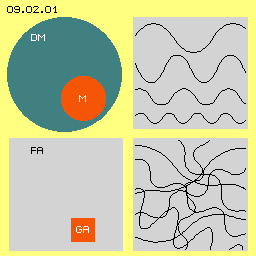 Expedient would be the assumption, all volume of universe is build by a real existing substance and to call that materia the ´Aether´. The aether is not dark but only invisible for us. It is completely transparent, so marked below left as light-grey face FA. We can directly register only five percent of, at its maximum, which here are represented by the red face GA.
Expedient would be the assumption, all volume of universe is build by a real existing substance and to call that materia the ´Aether´. The aether is not dark but only invisible for us. It is completely transparent, so marked below left as light-grey face FA. We can directly register only five percent of, at its maximum, which here are represented by the red face GA.
So it makes sense to assume, whole universe exists by a real substance. The major part is free of known material particle and these regions are called ´Free Aether´. The ´nothing´ within atoms naturally is also that real aether. However it does not only ´penetrate´ the known materia, but all atoms throughout and exclusive exist by that matter.
At the inter-galactic regions far outside of space, merely exist ´material particles´, nevertheless these rooms are not calm. Numberless radiations of different kind are running through the aether, like upside right at this picture simplistic is marked by diverse wave-shaped curves. The ´electromagnetic waves´ come from all directions, like below right simplistic is represented by some curves within that face.
Free electrons within a conductor are moving forward less than 1 mm/s. The sound within the air progresses about 330 m/s, thus at least 300000 times faster. The light-speed with its 300000 km/s moves faster again by factor 1000000. Photons are racing though Free Aether with that crazy speed, no matter their movements are crossing practically everywhere.
It´s the job of our brain to guarantee survival within the material world. For fast decisions it´s important to build fix categories, e.g. ´useful / negligible / dangerous´. We feel save only at stable ground and we handle solid tool and mostly solid (constructional-) parts - and these have no inner motion. Thus also within gapless solid aether no internal movements are possible - the instinctive first statement sounds respective our brain immediately judges.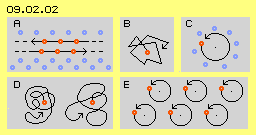 Indeed, the motion possibilities within that gapless aether are essentially reduced. Because there are no aether-particles, I call a certain spot within the aether an ´aether-point´. At picture 09.02.02 upside left at A some blue points are marked, which are ´stationary´ (like Free Aether is trembling only within a narrow range).
Indeed, the motion possibilities within that gapless aether are essentially reduced. Because there are no aether-particles, I call a certain spot within the aether an ´aether-point´. At picture 09.02.02 upside left at A some blue points are marked, which are ´stationary´ (like Free Aether is trembling only within a narrow range).
At this picture at D left side a motion is sketched, resulting of many short circle-sections (realiter into all three dimensions same time). Like this, one can imagine the ´chaotic´ swinging at narrow space of the Free Aether (which however will move all times at ´round´ tracks, thus never edged like sketched at B). Naturally at a place the aetherpoints can swing more calm at some longer stretched sections, like marked at D right side. The aetherpoints with such tracks are steady ´trembling´, nevertheless the aetherpoints of Free Aether are named to be ´stationary´. A ´rotation´ occurs, if a point or some neighbouring points are moving around a common fulcrum (see upside right at C). Strictly opposite, within the aether only ´swinging´ is possible, where each point is turning around its own fulcrum and all neighbours are moving parallel to. That motion-pattern thus corresponds to a ´sander´. A point left side from centre keeps left all times, a point right side all times keeps right, below remains below, upside point is all times positioned upside of centre. Thus a whole face of aether is ´wobbling´ likely. At this animation both shapes of motions are visualized: left side shows the rotation and right side shows the swinging motion (of these six aetherpoints and same time all neighbours at the black connecting lines and also all aether between). This parallel swinging of a whole face is an essential characteristic of all aether movements.
A ´rotation´ occurs, if a point or some neighbouring points are moving around a common fulcrum (see upside right at C). Strictly opposite, within the aether only ´swinging´ is possible, where each point is turning around its own fulcrum and all neighbours are moving parallel to. That motion-pattern thus corresponds to a ´sander´. A point left side from centre keeps left all times, a point right side all times keeps right, below remains below, upside point is all times positioned upside of centre. Thus a whole face of aether is ´wobbling´ likely. At this animation both shapes of motions are visualized: left side shows the rotation and right side shows the swinging motion (of these six aetherpoints and same time all neighbours at the black connecting lines and also all aether between). This parallel swinging of a whole face is an essential characteristic of all aether movements.
The movements within the aether however are not limited to that pure similar behaviour of points. At picture 09.02.04 upside left at A are drawn three neighbouring points, which are connected by a black line. At such ´connecting-lines´ numberless points are neighbouring, which are swinging analogue. As a simple track again a circle is marked. The circle left side shows a relative short radius, which is increasing towards right side. All point of the connecting-line keep constant distance between. However the right point is swinging at wider track as the points left. The whole connecting-line is moving in shape of a cone-mantle (marked light red).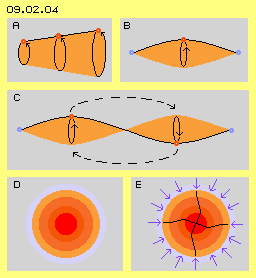 This simple crank is not already the optimum shape for a local limited swinging unit, because e.g. all aetherpoints upside must momentary also take a high position. A limitation for a local unit is achieved, if two such cranks are combined to a ´double-crank´ (by coarse comparison corresponding to the crank-shaft of a two-cylinder-motor). This point-symmetric arrangement is shown at this picture at the middle at C.
This simple crank is not already the optimum shape for a local limited swinging unit, because e.g. all aetherpoints upside must momentary also take a high position. A limitation for a local unit is achieved, if two such cranks are combined to a ´double-crank´ (by coarse comparison corresponding to the crank-shaft of a two-cylinder-motor). This point-symmetric arrangement is shown at this picture at the middle at C.
So at the one hand exits the Free Aether with its ´nervous trembling´ at narrow tracks. At the other hand exist local areas of Bound Aether, which show swinging movements better structured and at tracks longer stretched. The local units have no fix borders, but all around exists a transition-area, where the gradual stretching of tracks occurs by increasing radius of circled sections.
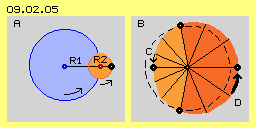 An other important characteristic of aether movements is schematic shown at picture 09.02.05. Upside was mentioned, all aether is swinging at sections or round tracks, also by multiple overlays. Simplistic one can imagine the motion at a circle track. At this picture left side e.g. a circling motion with radius R1 exists (marked by blue circled face).
An other important characteristic of aether movements is schematic shown at picture 09.02.05. Upside was mentioned, all aether is swinging at sections or round tracks, also by multiple overlays. Simplistic one can imagine the motion at a circle track. At this picture left side e.g. a circling motion with radius R1 exists (marked by blue circled face).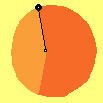 This animation visualizes the motion process: right side the aetherpoint is moving much faster than at left side. There is a phase of acceleration and following phase of deceleration. A stroke-component comes up, which at previous picture is marked by thick arrow D at the right side. This fast stroke is compensated by the slower motion at the other side, like marked by small arrow C.
This animation visualizes the motion process: right side the aetherpoint is moving much faster than at left side. There is a phase of acceleration and following phase of deceleration. A stroke-component comes up, which at previous picture is marked by thick arrow D at the right side. This fast stroke is compensated by the slower motion at the other side, like marked by small arrow C.
That first instinctive ´Impossible!´ thus is only valid for solid bodies of our experienced material world. Within the part-less aether are no gaps, nevertheless most variable movements are possible. However the motion-possibilities are reduced respective just this results certain necessities of appearances. A motion can only take place, if an aetherpoint takes the place, which - same time - got ´empty´ by a corresponding motion. Generally this is only possible, when all processes finally are running back to their starting points. As all movements in principle are running into all three directions same time, local motion-units can come up only in shape of spheres (e.g. like atoms) or disks (like e.g. galaxies) or flat faces (e.g. like charge on conductors).
The appearances and processes of electric-technics are based on these properties of real existing aether. The most important characteristics are described upside. For background knowledge it would make sense to study the comprehensive considerations of my Aether-Physics (in 2003 and following years with parts 01 up to 04). Since 2009 with part 08. ´Something Moving´ I was able to define the properties of the aether even more precise and to give plausible explanations for many ´phenomena´ and diverse unsolved problems. At previous year I did show that ´Evert-Aether-Theorem´ by a graph at the summary of that previous part.
09.03. Relevante Appearances
09. Aether-Elektric-Technics